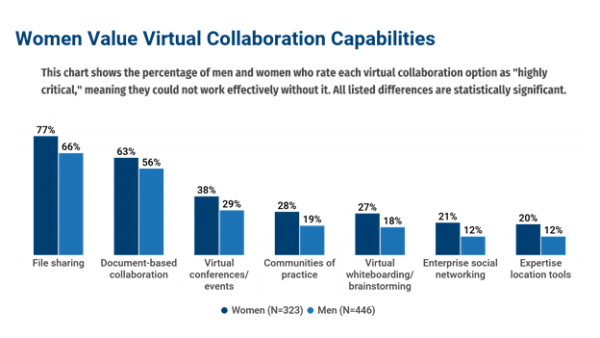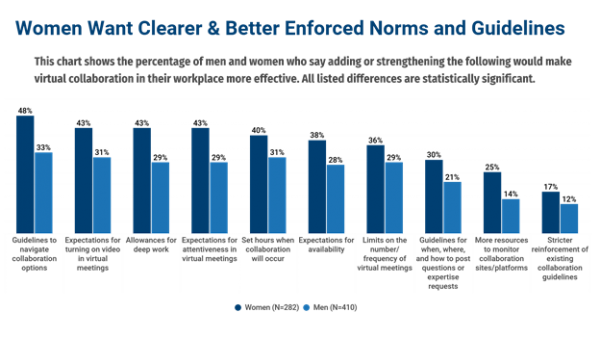
I’ll start off by saying: Differences between men and women in the workplace tend to be overblown. Not all women are timid and overly self-conscious, nor are they empathetic superheroes inherently suited to leadership and collaboration. People vary widely, regardless of gender, and anything unique in women's work experience is likely a result of how corporate structures and cultures treat women, rather than any innate characteristics.
This left me scratching my head at data from APQC’s Virtual Collaboration: Rules of the Road survey, which shows significant variations between men’s and women’s responses. Across 800+ participants, women are both more likely to see virtual collaboration tools as critical and to want better policies and norms to regulate virtual collaboration. The data made me wonder: Do men and women simply approach corporate collaboration differently? Or do the same policies and attitudes that cause women to be stereotyped, judged, and overlooked also shape their response to working online?
There’s no simple answer, but the survey results provide interesting clues.
Women See Knowledge Management and Collaboration Tools as Indispensable
The first major difference is that more women see virtual collaboration enablers as “highly critical,” meaning they could not work effectively without them. There are statistically significant differences for core knowledge management approaches—including communities of practice, enterprise social networks, expertise location tools, and virtual events—as well as newer tools for virtual brainstorming and document-based collaboration. Women are also more likely to say that virtual communities and chat groups have become more critical for obtaining needed information and expertise since the onset of the COVID-19 pandemic. The differences aren’t massive, but all are statistically significant.
One interpretation is that women are more naturally collaborative than men, and thus drawn to structured communication and knowledge-sharing channels. But there’s another way to look at it. Women, at least in some industries, have less access to the traditional professional networks these platforms seek to replicate. If an employee has fewer connections or finds it harder to build collegial relationships, she may seek answers through communities, networks, and expertise location tools. I suspect women depend more heavily on these resources because they fill gaps in their professional experience.
This theory is reinforced by the top benefits and challenges men and women cite for virtual collaboration. Women are significantly more likely to extol the efficiency of collaborating virtually: Among the top three benefits, 42% of women (vs. 34% of men) list getting things done faster, and 49% (vs. 40% of men) list more to-the-point conversations with less small talk. If women find cultivating offline professional relationships arduous and time-consuming, they will gravitate toward streamlined virtual options. By contrast, men are nearly twice as likely as women to say it’s harder to find the right colleagues to connect and collaborate with virtually. It’s possible this is because they’re less engaged in available online tools, but it may also reflect the robust support they’re used to getting from their in-person networks.
Women Clamor for Clearer Rules and Guidelines
The second disparity is that women are much more likely to say that better rules for virtual collaboration would make their workplace more effective. We saw statistically significant differences between men and women on almost all the policies and norms we asked about, including:
• Expectations to turn on video and remain attentive during virtual meetings
• Guidelines to navigate collaboration options and select the right channel
• Allowances to limit meetings, restrict collaboration to certain times, or block time for solitary tasks
• Additional resources to monitor platforms and enforce existing guidelines
Many respondents—both men and women—expressed concerns about the “wild wild west” nature of virtual collaboration environments where employees receive little guidance and make up the rules as they go along. However, women seem particularly frustrated and frazzled by the lack of enforced structure. I can’t explain this fully, but I have a few ideas.
I think female employees, on the whole, worry more about what colleagues think about them. Again, I don’t see this as an innate gender characteristic, but rather a reflection of organizational culture and lived experience. Compared to male colleagues, women are more frequently criticized for being aggressive, loud, provocative, emotional… the list goes on. Women with families also contend with stereotypes about their split focus (and this becomes an even bigger issue when working remotely). Even in progressive offices where such prejudice is rare, women remain attuned to the cultural undercurrents that make them more vulnerable.
As a result, women are more likely to fret about how they position themselves in the virtual workplace and interact with coworkers online. Am I asking this question in the right place, to the right person, in the right way? Will so-and-so think I’m slacking if I don’t respond immediately? Do I need to keep my phone with me after hours? These same women feel less comfortable saying “no”—for example, declining a meeting they don’t have time for, or disconnecting to focus on an important project. I suspect many prefer to see teammates on camera to ensure they’re being heard and to get visual feedback on how a presentation or conversation is progressing.
Whether externally or self-imposed, the pressure to be persistently available and attentive to others is exhausting. This is true for all employees, but—according to this data—particularly acute for women. Establishing clear corporate policies and norms would go a long way to alleviate this stress.
If people of all genders are told when, where, and how to collaborate, they’ll also understand the flip side: when it’s OK to disengage. They won’t have to guess what’s expected, overcompensate, overanalyze their own contributions, and become frustrated with continued chaos and uneven participation. Fixing these problems is, of course, important to everyone's sanity and work/life balance. But it’s also necessary to facilitate the kind of creative, strategic, and analytic work that requires sustained concentration.
If you want to hear more about our virtual collaboration research, I'm hosting a webinar, Take Virtual Collaboration to the Next Level, to share the most interesting takeaways on January 27. You can also dig into the data and analysis in the Virtual Collaboration: Rules of the Road collection.

